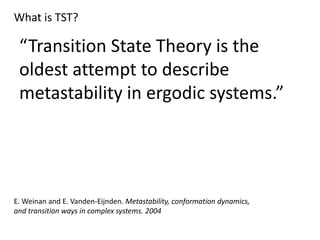Transition State Theory
- 1. Horacio González Duhart hgd20@bath.ac.uk
- 2. What is TST? “Transition State Theory is the oldest attempt to describe metastability in ergodic systems.” E. Weinan and E. Vanden-Eijnden. Metastability, conformation dynamics, and transition ways in complex systems. 2004
- 3. “Transition State Theory is the oldest attempt to describe metastability in ergodic systems.” Momentum Mass Position Acceleration Potential energy
- 4. “Transition State Theory is the oldest attempt to describe metastability in ergodic systems.” C TST simplification:
- 5. Example of metastable sets in the context of TST:
- 6. Example of metastable sets in the context of TST:
- 7. Example of metastable sets in the context of TST:
- 8. “Transition State Theory is the oldest attempt to describe metastability in ergodic systems.” Ergodic theorem IF Then Just think of Jack… he is not always wearing q shoes, nor he is not always without them… he continuously keeps changing from one state to the other.
- 9. “Transition State Theory is the oldest attempt to describe metastability in ergodic systems.” “Rate of reaction is the rate of change in the concentration of one of the reactants or products” N. E. Henriksen and F. Y. Hansen. Theories of Molecular Reaction Dynamics. 2008
- 10. Ergodicity
- 11. Ergodicity Metastable
- 12. Ergodicity Metastable Assuming Gibbs distribution
- 13. Ergodicity Metastable Assuming Gibbs distribution
- 14. “Transition State Theory is the oldest attempt to describe metastability in ergodic systems.” Original papers from 1935, 1938. Several issues have been addressed, and current research involves techniques on: 1. Dividing surfaces 2. Transition path sampling, reactive trajectories C q 3. Finite String and MCMC methods
- 15. No Jack was hurt during the making of this presentation.
- 16. Horacio González Duhart hgd20@bath.ac.uk
















